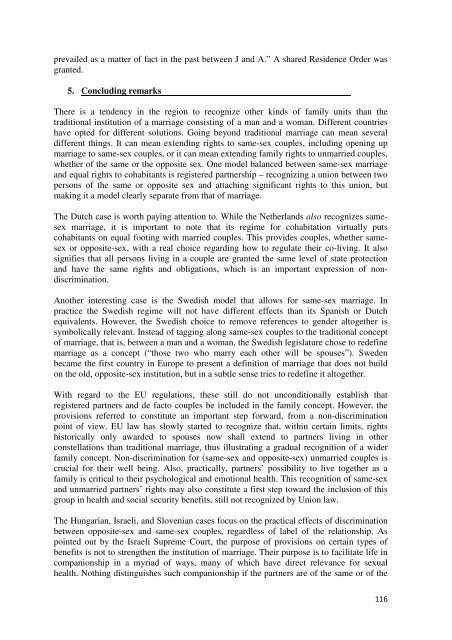Johanna Westeson - The ICHRP
Johanna Westeson - The ICHRP
Johanna Westeson - The ICHRP
You also want an ePaper? Increase the reach of your titles
YUMPU automatically turns print PDFs into web optimized ePapers that Google loves.
prevailed as a matter of fact in the past between J and A.” A shared Residence Order was<br />
granted.<br />
5. Concluding remarks<br />
<strong>The</strong>re is a tendency in the region to recognize other kinds of family units than the<br />
traditional institution of a marriage consisting of a man and a woman. Different countries<br />
have opted for different solutions. Going beyond traditional marriage can mean several<br />
different things. It can mean extending rights to same-sex couples, including opening up<br />
marriage to same-sex couples, or it can mean extending family rights to unmarried couples,<br />
whether of the same or the opposite sex. One model balanced between same-sex marriage<br />
and equal rights to cohabitants is registered partnership – recognizing a union between two<br />
persons of the same or opposite sex and attaching significant rights to this union, but<br />
making it a model clearly separate from that of marriage.<br />
<strong>The</strong> Dutch case is worth paying attention to. While the Netherlands also recognizes samesex<br />
marriage, it is important to note that its regime for cohabitation virtually puts<br />
cohabitants on equal footing with married couples. This provides couples, whether samesex<br />
or opposite-sex, with a real choice regarding how to regulate their co-living. It also<br />
signifies that all persons living in a couple are granted the same level of state protection<br />
and have the same rights and obligations, which is an important expression of nondiscrimination.<br />
Another interesting case is the Swedish model that allows for same-sex marriage. In<br />
practice the Swedish regime will not have different effects than its Spanish or Dutch<br />
equivalents. However, the Swedish choice to remove references to gender altogether is<br />
symbolically relevant. Instead of tagging along same-sex couples to the traditional concept<br />
of marriage, that is, between a man and a woman, the Swedish legislature chose to redefine<br />
marriage as a concept (“those two who marry each other will be spouses”). Sweden<br />
became the first country in Europe to present a definition of marriage that does not build<br />
on the old, opposite-sex institution, but in a subtle sense tries to redefine it altogether.<br />
With regard to the EU regulations, these still do not unconditionally establish that<br />
registered partners and de facto couples be included in the family concept. However, the<br />
provisions referred to constitute an important step forward, from a non-discrimination<br />
point of view. EU law has slowly started to recognize that, within certain limits, rights<br />
historically only awarded to spouses now shall extend to partners living in other<br />
constellations than traditional marriage, thus illustrating a gradual recognition of a wider<br />
family concept. Non-discrimination for (same-sex and opposite-sex) unmarried couples is<br />
crucial for their well being. Also, practically, partners’ possibility to live together as a<br />
family is critical to their psychological and emotional health. This recognition of same-sex<br />
and unmarried partners’ rights may also constitute a first step toward the inclusion of this<br />
group in health and social security benefits, still not recognized by Union law.<br />
<strong>The</strong> Hungarian, Israeli, and Slovenian cases focus on the practical effects of discrimination<br />
between opposite-sex and same-sex couples, regardless of label of the relationship. As<br />
pointed out by the Israeli Supreme Court, the purpose of provisions on certain types of<br />
benefits is not to strengthen the institution of marriage. <strong>The</strong>ir purpose is to facilitate life in<br />
companionship in a myriad of ways, many of which have direct relevance for sexual<br />
health. Nothing distinguishes such companionship if the partners are of the same or of the<br />
116
















